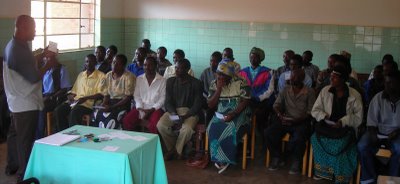Mobiles in Malawi - Implementing the project
- Mobiles in Malawi main page
- Tuberculosis, Meet FrontlineSMS
- SMS for Patient Care, in its Truest Form
- Antiretroviral Texting
- A Guide to Building an SMS Network into a Rural Healthcare System
During the summer of 2008, Josh Nesbit traveled to St. Gabriel’s Hospital in Namitete, Malawi, with 100 recycled cell phones and a copy of FrontlineSMS – a free program developed by Ken Banks to act as a central text-message hub. His plan was to implement a text-based communications network for the hospital and the Community Health Workers (CHWs).

In groups of 10-15, CHWs were brought to the hospital, given cell phones, and trained in text messaging. The volunteers’ locations were mapped, and the phones were disseminated throughout the catchment area.
Stationed at the hospital, a laptop running FrontlineSMS coordinates the health network’s activities. The day-to-day program operations were handed over to hospital staff within two weeks. FrontlineSMS is operated by Alexander Ngalande, a nurse who heads the hospital’s home-based care (HBC) program.
Mr. Ngalande, on setting up and running FrontlineSMS: “It was very quick. And, people didn’t know that this thing could work here – because, it’s our first time to have this kind of system whereby people can directly communicate with the hospital using FrontlineSMS. It’s simple and straightforward.”
Impact on patient care and hospital operations
The SMS network has enabled the following:
- Requests for remote patient care – CHWs text the hospital staff when immediate care is needed, and the patient is subsequently visited by the Home-Based Care mobile unit. Patient location and health status are communicated, allowing the mobile team to bring needed drug supplies. According to Dickson Mtanga, a CHW in the pilot program, “When I have a problem with my patient, I just send a message to the hospital, at once. If they are helped and assisted, I feel so much better.”
- Patient tracking – The hospital is now able to track patients in their distant communities. According to Mr. Ngalande, “Each and every department is free to use FrontlineSMS. We have ART, home-based care, TB, PMTCT (prevention of mother to child transmission). For example, TB patients who are not coming for their appointments, we use FrontlineSMS to text volunteers close to the patient’s village. It’s easy to get feedback from the community.”
- Checking drug dosages – CHWs in the field have been given basic drug supplies (e.g. Panadol, ferrous sulfate, eye ointments) for primary care. The CHWs now check drug dosages and uses within seconds. When FrontlineSMS receives an SMS with a drug name, it automatically responds to the health worker with that drug’s information.
- Patient updates – CHWs regularly update the hospital staff with regard to patient status, including reporting patient deaths. These messages have created a post-discharge connection to patients’ well being.
- Coordinating home-based care visits – In addition to responding to medical emergencies in the communities, the home-based care unit also follows a schedule of home visits – sometimes checking on patients who have been discharged recently. Other patients are enrolled in the hospital’s palliative care program. Before traveling to the patients’ villages, the mobile unit text messages CHWs close to the clients they plan to visit. Any response by the CHW (e.g. “Patient is not at home.”) is forwarded to the mobile team’s phone, allowing medical staff to maximize their productivity by visiting available patients.
- CHW-to-CHW communication and group mobilization – CHWs are now communicating and collaborating. All texts are shuttled through the hospital, and FrontlineSMS commonly relays messages and requests between CHWs. This has been an important function in setting meeting dates for Village AIDS Committees and linking HIV/AIDS support groups. Hospital activities throughout the catchment area (including microfinance and positive living programming) are organized using the SMS network. Baxter Lupiya, a CHW in TA Kalolo, notes, “We used to travel a long distance. Now, we have easy communication with others. The program must be continued, because it is so good!”
- Integrating connectivity into HIV counseling – HIV Counseling and Testing (HCT) at the hospital has been augmented because of the SMS network. If a client tests positive, he or she is paired with an HIV-positive CHW with a phone – these volunteers act as models for positive living and provide comfortable, relatable links to the hospital.
Other benefits of the SMS network:
- CHW status – The connection to hospital services has solidified the CHWs’ role as legitimate healthcare representatives in their villages. The patients and their communities, according to the program’s participants, have noticed the phones, each one clearly marked with the hospital’s logo.
- Incentives and accountability – The phones provided very concrete incentives for the volunteer work done by the CHWs. The SMS network created, for the first time, a way to track the CHWs’ activities, paving the way for more informed decisions regarding allocation of resources (e.g. which CHWs should receive bicycle ambulances).

- For more stories, background, and implementation information, please visit Josh’s blog at http://www.jopsa.org/
- In February 2009, FrontlineSMS:Medic was launched to extend the capabilities of this software and bring it to health centers across several continents. Please visit http://medic.frontlinesms.com/ for the latest information.
- You can reach Josh via email at josh.nesbit@jopsa.org
